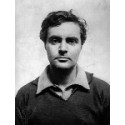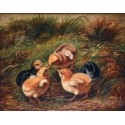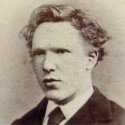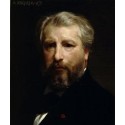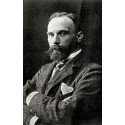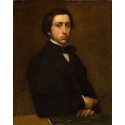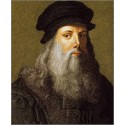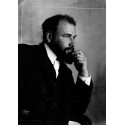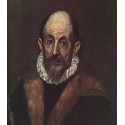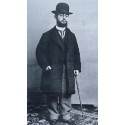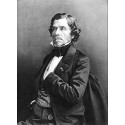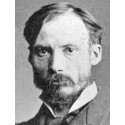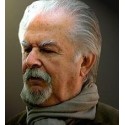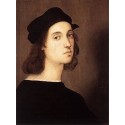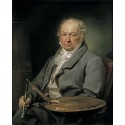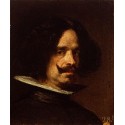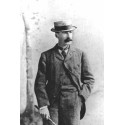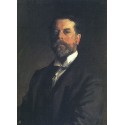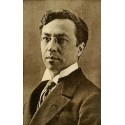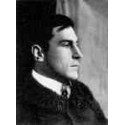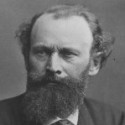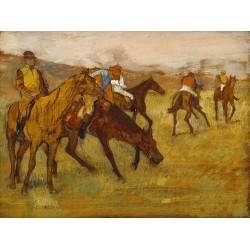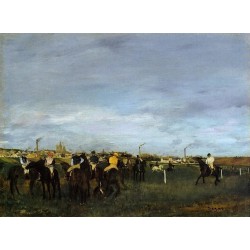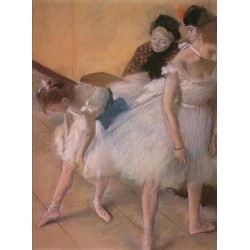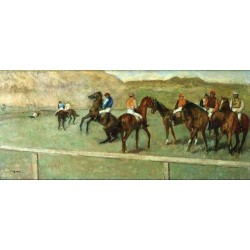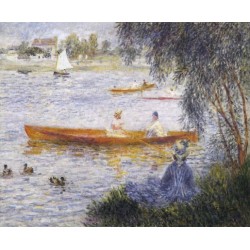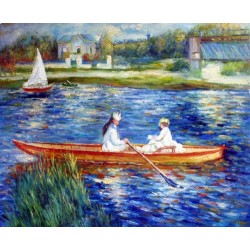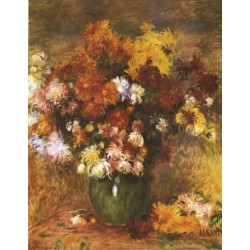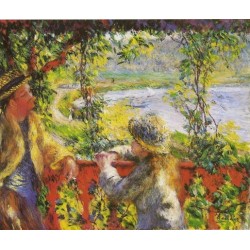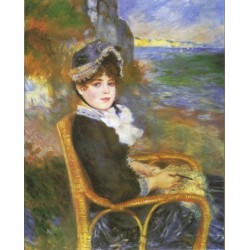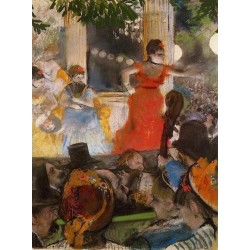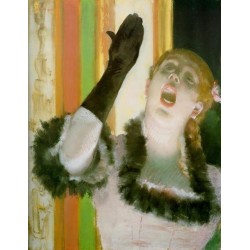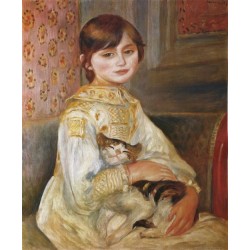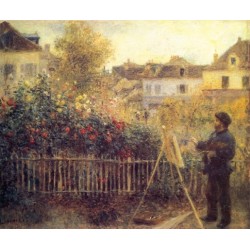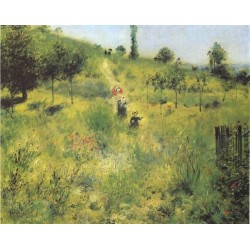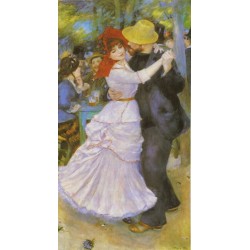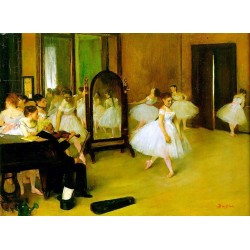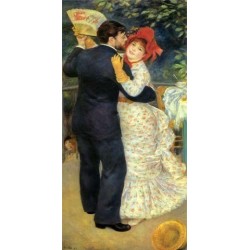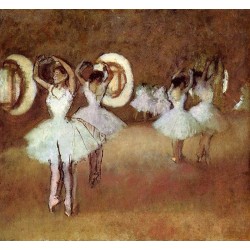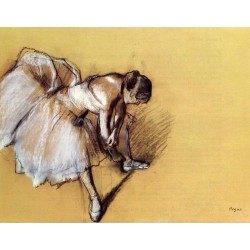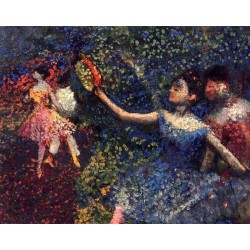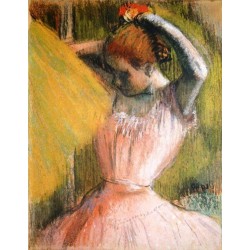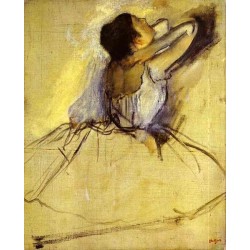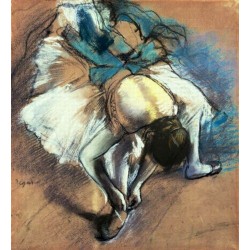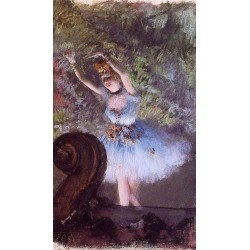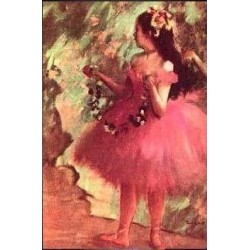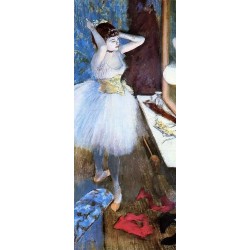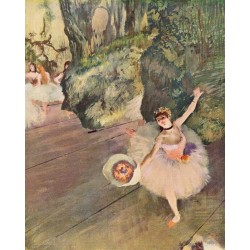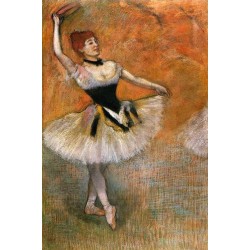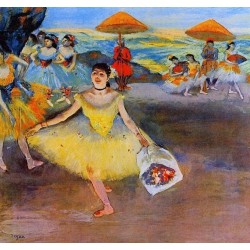Subcategories
-
Amedeo Modigliani
Amedeo Modigliani was an Italian-Jewish painter and sculptor and lived a life of excess. Addicted to alchohol, drugs and women, he died very poor and young in Paris in the year 1920, at the age of thirty five of tubercular meningitis.
Despite all of this, Modigliani’s output was considerable and his artwork is currently the subject of a blockbuster exhibition at Tate Modern, in London.
This major retrospective is actually the most comprehensive Amedeo Modigliani exhibition that was ever held in the United Kingdom. With over 100 artworks, it brings together a wide range of his portraits, landscapes, sculptures and twelve of his iconic, languorous, female nudes, some of which have never been shown in the the United Kingdom before.
These very seductive figures, such as “Reclining Nude on a White Cushion” in 1917, “Female Nude” in 1916 and “Seated Nude” in 1916 constitute many of his very best-known atworks today. But in the early 20th century, these provocative paintings proved controversial, shocking the wole French establishment.
In 1917, they were included in Amedeo Modigliani’s solo exhibition in his lifetime, but were also subject to censorship on grounds of indecency: A police commissioner objected to Modigliani’s depiction of pubic hair, finding it very offensive.
However, these artworks inclusion here is one of the exhibition’s highlights. The models appear very relaxed, their bold, curvaceous bodies and dark, almond shaped eyes gaze out with real coquettish confidence.
The sensuality of these model figures suggests changes in the lives of many young women, who then became increasingly independent. According to curator Nancy Ireson, women were of their moment in the 1910s, and their decision to pose was really based on economics. Models were actually paid five francs, says Ireson, which was approximately twice the average daily wage of a female factory worker during World War I.
He was born in 1884 in Livorno into a middle class Sephardic Jewish family, Amedeo Modigliani then moved to Paris in 1906 in order to develop his art career.
Bohemian, cosmopolitan Paris was the center of the art world and Amedeo Modigliani was actually “blown away by what he saw as generations colliding,” says Ireson.
The city was a real place of excitement and offered new ideas and opinions that challenged him. He started to associate with poets, writers and musicians and soaked up the influence of artworks by other artists, such as the recently deceased Paul Cézanne, as well as contemporary artists including Toulouse-Lautrec and Picasso.
This then resulted in Amedeo Modigliani changing his traditional style paintings for broken brushwork and bright colors. “You cannot imagine what new kind themes I have thought up in violet, deep orange and ochre,” he then declared.
But Modigliani also had very strong ambitions to be a great sculptor, and one gallery was devoted to a display of his Heads, that was produced between 1911-1913. The shape of all these carvings reflects his interest in Egyptian, Cambodian and even African art.
On a visit one day to his studio, Amedeo Modigliani’s friend, the British sculptor Jacob Epstein, saw a few of his sculpted Heads and said that, “At night he would place a few candles on the top of each one and the effect was that of a primitive temple. A legend of the quarter said that Modigliani, had gone under the influence of hashish, embraced these sculptures.”
Although Modigliani’s aspirations as a great sculptor would be short lived due to a lack of funds and ill health — the dust from carving stones may have aggravated his breathing — his developing painting style of elegant, long necks, elongated, oval faces and almond eyes would then later feature in his paintings.
Amedeo Modigliani followed his foray into stone with portraiture and there are several rooms that are dedicated to pictures of his patrons and his friends, many of whom were other artists also living in Paris. These also included Juan Gris, Diego Rivera and Pablo Picasso as well as fellow Jews such as Moïse Kisling, Lithuanian cubist sculptor Jacques Lipchitz, and the great poet and painter Max Jacob, with whom Modigliani often discussed the subject of faith. Jacob has been the subject of a series of pictures and a graphite drawing of him, completed in the year 1915, shows Amedeo Modigliani’s handwritten inscription to his close friend who was also his “brother.”
Amedeo Modigliani was part of the Jewish artistic community, says co-curator Simonetta Fraquelli. “He was actually very proud of being Jewish and would not hide it.”
But Fraquelli was then quoted by the Jewish Chronicle as saying that Amedeo Modigliani was also a little different from his contemporaries, in that the first time he ever faced prejudice was in Paris — where many of the Jewish artists had left Eastern Europe for France due to anti-Semitism.
Amedeo Modigliani’s Jewishness is addressed in the exhibition as part of his special story without actually focusing exclusively on it, explains Ireson. The curators then chose not to explore Modigliani’s specific experience of anti-Semitism, says Ireson, having taken the view that a lot had already been written by academics on the subject.
Although Modigliani had known many people, there are a few individuals who appear repeatedly in his artwork.
In his latter years, he turned to his close friends and his lovers as willing and convenient models. They included Modigliani’s art dealer and good friend, the Jewish poet and writer Léopold Zborowki, and Zborowki’s partner, Anna Sierzpowski, also known as Hanka.
Despite him having had a succession of tempestuous relationships with many women, Jeanne Hébuterne became one of the most important people in his life. She became the mother of his child and Amedeo Modigliani’s most regular and favorite sitter — he painted her more than twenty times.
The couple met when she was a Nineteen-year-old art student and then moved in together, getting engaged against the wishes of her Roman Catholic parents. One of the last painting portraits of Jeanne (“Jeanne Hébuterne,” 1919), depicts her seated, one finger resting on her cheek with the rest of her hand curling, delicately, right under her chin.
Despite the extensiveness of the artworks that have been assembled in the exhibition, there is a lack of focus and also a frenetic quality about the show, mainly due to the inclusion of its countless and tonally similar painting portraits. There are actually some compelling pieces, but the excess of his artworks dilutes them — the sheer volume is very overwhelming.
Where the painting exhibition excels is in its integrated virtual reality experience, The Ochre Atelier. Through the use of a headset, all visitors can step into Amedeo Modigliani’s last studio in Paris. This used for the first time at Tate, this immersive, thrilling recreation also includes first person accounts by those who knew the artist.
The show’s highlights are very impressive, as are its ambition and its scale. Its overreach, however, is also its shortcoming. Most of the artwork does not match the artist’s penchant for reckless overindulgence, and lacks the sufficient drama and vibrancy to sustain an exhibition of this size. -
Arthur Fitzwilliam Tait
Arthur Fitzwilliam Tait (February 5, 1819 – April 28, 1905) was an American artist who is known mostly for his paintings of wildlife. During most of his career, he was associated with the New York City art scene. Tait was born in Lively Hall near Liverpool, England. At eight years old, because his father went bankrupt he was sent to live with relatives in Lancaster. It is during that time that he became attached to animals. Later on, in Manchester, England, Agnew & Zanetti Repository of Art acquired Arthur Tait who began self-learning to paint, as a twelve-year-old boy. His work consisted mostly of reproduced lithography that were exposed for Agnew's exhibitions. In 1838, he left the Agnew lithography reproduction business to marry.
-
Claude Monet
Impressionism emerged in France within the middle of the nineteenth century and The famous paintings by Monet is one among the pioneers of this revolutionary front. Claude Monet has painted a number of the best masterpieces of Impressionism and his works has been revered by critics and folks alike.
Here are 10 of Monet's Famous Paintings.
#1 Water Lilies (Nympheas)
Monet’s series of the “Nympheas” are represented as “The Sistine Chapel of Impressionism”. The series consists of approximately 250 famous oil paintings by Monet which were painted throughout the last thirty years of his life. They are now on display in museums all around the world. One of the paintings of the series was sold for 80 million at an auction in 2008. The dazzling complexness of color and light-weight within the “Nymphéas” panels opens the viewer’s eyes to the unbelievable diversity of nature and to the depth and mystery of the life it sustains. An amazing issue regarding these works is that Monet’s seeing was badly deteriorating because of cataract while he painted most of these masterpieces. Giovanna Bertazzoni, in Christie’s auction house director and the head of impressionist and modern art, had said “Oscar Claude Monet’s water-lily paintings area unit amongst the foremost recognized and celebrated works of the twentieth Century and were vastly influential to several of the subsequent generations of artists”.
#2 Impression, Sunrise
The second of the series of famous paintings by Monet is legendary for giving a reputation to the Impressionist movement and has currently become a illustration image of Impressionism. It was not well taken by the critics and the term Impressionist was coined in a satirical review by Louis Leroy in which he went to the extent of saying: “Wallpaper in its embryonic state is way more finished than that seascape.” However, the Impressionist movement, soon became so popular that it then spread to music and literature as well. The subject of the painting is that the harbor of urban center in France. It is noted for terribly loose brushstrokes that recommend instead of outline it. Monet uses color because the main issue to capture the terribly essence of the scene. An interesting thing regarding this painting is that if you create a black and white copy of it then the sun disappears virtually entirely.
#3 Rouen Cathedral series - Year: 1892 – 1893
The third of the series of famous paintings by Monet captures the facade of Rouen Cathedral in France at different times of the day and year, showcasing its changes with varying light conditions. While studying these paintings it is noted that Monet broke painting tradition and cropped the subject so that only a portion of the facade is seen on the canvas. Painting the series was a difficult task for Monet. He wrote, ‘Things don’t advance very steadily, primarily because each day I discover something I hadn’t seen the day before… In the end, I am trying to do the impossible.’ He was, however, helped by his ability to capture the essence of the scene quickly and finish it later from memory.
#4 Haystacks Series - Year: 1890 – 1891
Among Monet’s most famous paintings and notable works, the Haystacks series primarily refers to 25 canvases that he painted in the above mentioned period. The subjects of the paintings are haystacks in the fields near Monet’s home in Giverny, France which he noted during a casual walk along the countryside. The series is famous for repeating the same scene to showcase differences in perception of sunshine across varied times of day, seasons, and types of weather. These paintings made Monet the first painter to paint so many illustrations of the same subject matter.
#5 Houses of Parliament series Year: 1900 – 1905
The fifth of the series of famous paintings by Monet was during his stays in London in this time period. Monet painted this series whose subject is the Palace of Westminster, home of the British Parliament. All the 19 paintings of the series are of the same size and depict the same scene from the same viewpoint but they showcase varied weather circumstances and varied times of the day. One of the paintings of the series fetched more than 20 million dollars in an auction in 2004.
#6 Poplar Series Year: 1891
This famous painting series by Monet consists of 24 paintings of the magnificent trees along the banks of the Epte River, a few kilometers upstream from Monet’s house. A floating painting studio was moored in place and he reached there by a small boat. However, before he could finish the town wanted to auction and sell the trees, so in order to continue, Monet bought the trees and then sold them after he finished painting. There were three types of groups for these paintings -first group was three poplars with an ‘S’ curve in the back; second group was a lot of poplars with an ‘S’ curve; third group were poplars with their reflections. A crucial element of the paintings was the ‘S’ curve that was outlined by the top of the trees; although it made critics term the paintings too decorative initially, as time passed the ‘S’ curve became a highlight and selling point for the paintings.
#7 San Giorgio Maggiore at Dusk Year: 1908 – 1912
Monet had no intention of painting once he visited Venice in 1908 as it had already been represented by various artists. However, during his visit he was entranced by the sights in the city and he called for his painting material. He began a series of preliminary works which he completed much later when he returned home. Among these was this painting which is also referred to as Venice at Dusk and which became one of Monet's most popular and famous paintings. It is noted for thin, light brushstrokes and masterful depiction of light and the movement of water.
#8 Camille or The Woman in the Green Dress Year: 1866
This is the famous painting that first brought recognition to Monet. It fetched Monet 800 francs, a great amount for a struggling artist at that time. It showed his 1st wife Camille Doncieux in a beautiful green dress. Camille features in several other paintings by her husband, including, Women in the Garden, and On the Bank of the Seine, Bennecourt. The painting is from the early period of Monet’s career when he painted in realist style as opposed to Impressionist.
#9 Woman with a Parasol Year: 1875
One of his earlier works of famous paintings by Monet depicts his first wife Camille Doncieux with their elder son Jean. Camille is holding a parasol or a light umbrella and it seems that she is catching a glimpse of someone looking at her. The painting is early evidence of Monet focusing more on light and color as opposed to line and shape.
#10 Bain à la Grenouillère Year: 1869
The tenth of the series of famous paintings by Monet La Grenouillère was a popular middle class boating and bathing resort of those times. Monet wrote on September twenty five, 1869, “I do have a dream, a painting, the baths of La Grenouillère, for which I have made some bad sketches, but it is only a dream.” The painting below and one in the London National Gallery are probably one of the sketches with the original tableau having been lost. Renoir, who was very close to Claude Monet at the time, conjointly needed to try and do this painting. -
Vincent Van Gogh
Vincent Willem Gogh was born March thirty, 1853 – twenty nine Gregorian calendar month 1890 he was a Dutch post-Impressionist painter whose work, notable for its rough beauty, emotional honesty and daring color, had a extensive influence on 20th-century art. when years of painful anxiety and frequent bouts of mental state, he died aged thirty seven from a gunfire wound, typically accepted to be self-inflicted (although no gun was ever found). His work was then familiar to solely a few of individuals and appreciated by fewer still. Gogh began to draw as a toddler, ANd he continued to draw throughout the years that LED up to his call to become an creative person. He didn't begin painting till his late twenties, finishing several of his known works throughout the last 2 years of his life. in exactly over a decade, he made quite two,100 artworks, consisting of 860 murals and quite one,300 watercolors, drawings, sketches and prints. His work enclosed self portraits, landscapes, still lifes, portraits and paintings of cypresses, wheat fields and sunflowers.
-
William Bouguereau
William-Adolphe Bouguereau, Gregorian calendar month thirty, 1825 – August nineteen, 1905) was a French educational painter and traditionalist. In his realistic genre paintings he used mythological themes, creating trendy interpretations of classical subjects, with a stress on the feminine soma. throughout his life he enjoyed important quality in France and therefore the us, was given various official honors, and received high costs for his work. because the illustration salon painter of his generation, he was maligned by the Impressionist avant-garde. By the first twentieth century, Bouguereau and his art fell out of favor with the general public, due partially to dynamical tastes. within the Eighties, a revival of interest in figure painting light-emitting diode to a find of Bouguereau and his work. Throughout the course of his life, Bouguereau dead 822 celebrated finished paintings, though the whereabouts of the many are still unknown.
-
Waterhouse
Unveiling the Timeless Beauty of Waterhouse Paintings: A Dive into the World of Art
Step into the enchanting world of art as we dive deep into the timeless beauty of Waterhouse paintings. With every brushstroke, these masterpieces capture the essence of emotion and transport us to a realm filled with passion, mystery, and ethereal beauty. Renowned for his ability to infuse his artworks with a sense of romanticism, John William Waterhouse has left an indelible mark on the art world. Through his incredible talent, he has brought to life mythical creatures, captivating heroines, and breathtaking landscapes, all bathed in a delicate play of light and shadow. Join us on this journey as we unravel the stories behind his most iconic paintings, delving into the symbolism and narratives that make them so captivating. Whether you're an art enthusiast or simply curious about the power of visual storytelling, this exploration of Waterhouse's art is sure to leave you inspired and in awe of his enduring legacy. Get ready to immerse yourself in the mesmerizing world of Waterhouse's art, where beauty knows no bounds and imagination takes flight.
The Life and Influences of John William Waterhouse
John William Waterhouse was born in Rome in 1849 to English parents. His early exposure to the vibrant art scene in Italy sparked his passion for painting. Waterhouse's family later moved to London, where he studied at the Royal Academy of Arts. It was during this time that he was heavily influenced by the works of the Pre-Raphaelite Brotherhood, a group of artists who sought to revive the detailed and vibrant aesthetic of early Renaissance art.
Waterhouse's paintings often depicted scenes from mythology, literature, and history, showcasing his deep appreciation for the classics. He was particularly drawn to the works of Shakespeare, Tennyson, and Homer, finding inspiration in their timeless stories of love, tragedy, and heroism. This fascination with storytelling is evident in his art, as each painting tells a captivating narrative through its composition, colors, and symbolism.
Waterhouse's unique style combined the meticulous attention to detail of the Pre-Raphaelite movement with his own romantic flair. His use of vibrant colors, intricate patterns, and soft brushstrokes created a dreamlike quality that enhanced the emotional impact of his paintings. This distinct style, coupled with his ability to capture the human form with grace and sensitivity, established Waterhouse as a master painter.
The Themes and Symbolism in Waterhouse's Paintings
Waterhouse's paintings are rich with symbolism, inviting viewers to delve deeper into their meanings. One recurring theme in his art is the exploration of feminine beauty and its connection to nature. His depictions of ethereal women adorned in flowing garments and surrounded by lush landscapes evoke a sense of harmony between humanity and the natural world. These women often embody mythical figures or characters from literature, representing ideals of love, beauty, and strength.
Waterhouse also explored themes of love and desire in his paintings, often depicting passionate encounters between lovers or unrequited longing. His ability to capture the complexities of human emotion is evident in the expressions and body language of his subjects. Whether it's the yearning gaze of a lovestruck maiden or the pained expression of a spurned lover, Waterhouse's paintings evoke a deep sense of empathy and connection.
Another significant element in Waterhouse's art is the use of water as a symbolic motif. Water, with its reflective and transformative qualities, serves as a metaphor for the ever-changing nature of life and emotions. In many of his paintings, water acts as a boundary between different realms, representing the threshold between the conscious and the subconscious, the mortal and the divine. The interplay of light and water in his artworks creates a sense of enchantment and mystery, drawing viewers into a world where reality and imagination merge.
The Pre-Raphaelite Movement and Waterhouse's Place in Art History
To truly appreciate Waterhouse's art, it's important to understand his place within the context of the Pre-Raphaelite movement. The Pre-Raphaelite Brotherhood, formed in 1848, sought to challenge the prevailing artistic conventions of the time and return to the detailed and vibrant style of early Renaissance art. Led by artists such as Dante Gabriel Rossetti and John Everett Millais, the movement emphasized meticulous attention to detail, vibrant colors, and a focus on literary and mythological subjects.
While Waterhouse was not a member of the original Brotherhood, his art was heavily influenced by their ideals and aesthetics. He shared their love for storytelling and their fascination with mythology and history. Waterhouse's paintings often featured the same attention to detail and vibrant color palette that characterized the works of the Pre-Raphaelites.
Waterhouse's association with the Pre-Raphaelite movement helped solidify his place in art history. His art bridged the gap between the Pre-Raphaelite Brotherhood and the later Symbolist movement, which sought to explore the deeper meanings and emotions behind art. Waterhouse's paintings, with their intricate symbolism and evocative narratives, exemplified the ideals of the Symbolists, making him a significant figure in the transition from one movement to another.
Analyzing Waterhouse's Technique and Style
Waterhouse's technique and style are a testament to his mastery as a painter. His meticulous attention to detail is evident in every brushstroke, as he painstakingly captures the intricacies of fabric, hair, and skin. The vibrant colors he employed, often juxtaposed with soft, diffused lighting, create a sense of depth and dimensionality in his paintings.
One notable aspect of Waterhouse's technique is his use of glazes, a method employed by many Renaissance painters. By applying multiple thin layers of translucent paint, he was able to achieve a luminous effect, particularly in his depictions of water and skin. This technique adds a sense of ethereality to his art, enhancing the dreamlike quality for which he is known.
Waterhouse's skill in capturing the human form is also remarkable. His figures, whether male or female, possess a grace and sensuality that is both captivating and realistic. The attention to anatomical accuracy, coupled with his ability to convey emotion through facial expressions and body language, breathes life into his paintings and draws viewers into the narratives he creates.
Popular Waterhouse Paintings and Their Meanings
Waterhouse's body of work is vast and varied, encompassing a wide range of themes and subjects. Several paintings have become iconic symbols of his artistry and continue to captivate audiences to this day. Let's explore some of Waterhouse's most popular paintings and the meanings behind them.
1. "The Lady of Shalott" (1888): Based on Alfred Lord Tennyson's poem of the same name, this painting depicts the tragic story of a cursed lady who is confined to a tower. Waterhouse's portrayal of the Lady of Shalott captures her isolation and longing for freedom. The vibrant colors and intricate details in the tapestry surrounding her symbolize the rich inner world she creates through her art.
2. "The Siren" (1900): In this painting, Waterhouse depicts a seductive siren perched on a rock, luring sailors to their doom with her enchanting song. The siren's gaze and alluring pose convey both power and vulnerability, reflecting the complex nature of desire and temptation.
3. "Hylas and the Nymphs" (1896): Inspired by Greek mythology, this painting portrays Hylas, a young warrior, being enticed by nymphs into the water. The composition and lighting in this artwork create a sense of otherworldly beauty, while also alluding to the danger and temptation that lie beneath the surface.
4. "Ophelia" (1894): Waterhouse's interpretation of Shakespeare's tragic character Ophelia showcases his ability to capture the delicate balance between beauty and melancholy. The floating flowers and serene expression on Ophelia's face serve as symbols of her untimely demise and the fleeting nature of life.
Waterhouse's Legacy and Impact on Contemporary Art
Waterhouse's art continues to inspire and influence contemporary artists, as his timeless themes and evocative style resonate with audiences across generations. His ability to merge storytelling with visual aesthetics has had a profound impact on the world of art and visual media.
In the realm of contemporary art, many artists draw inspiration from Waterhouse's use of symbolism and narrative. They explore similar themes of femininity, mythology, and the interplay between reality and imagination. Waterhouse's legacy can be seen in the works of artists such as Mark Ryden, Audrey Kawasaki, and Ray Caesar, who incorporate elements of fantasy and storytelling into their art.
Waterhouse's influence extends beyond the art world and into popular culture. His paintings have been featured in films, music videos, and literature, further cementing his status as a cultural icon. The enduring appeal of his art lies in its ability to evoke emotions and transport viewers to a world of beauty and wonder.
Exhibitions and Museums Featuring Waterhouse's Artworks
Waterhouse's art can be experienced firsthand through exhibitions and museums dedicated to his work. These venues provide a unique opportunity to immerse oneself in the mesmerizing world he created and gain a deeper understanding of his artistic vision.
The Tate Britain in London houses an extensive collection of Waterhouse's paintings, including some of his most famous works. The museum regularly organizes exhibitions that showcase his art alongside that of other Pre-Raphaelite artists, offering a comprehensive exploration of the movement.
In addition to the Tate Britain, the Royal Academy of Arts and the Victoria and Albert Museum also feature Waterhouse's art in their collections. These institutions provide a valuable platform for art enthusiasts to appreciate and study his paintings in a curated setting.
Collecting Waterhouse Paintings: Tips for Art Enthusiasts
For art enthusiasts and collectors, owning a Waterhouse painting is a highly sought-after dream. However, given the rarity and value of his artworks, collecting Waterhouse paintings can be a challenging endeavor. Here are some tips for those interested in starting their own Waterhouse collection:
1. Research and Educate Yourself: Familiarize yourself with Waterhouse's body of work, his artistic style, and the historical context in which he created. This knowledge will help you make informed decisions when acquiring his paintings.
2. Seek Expert Advice: Consult with art experts, dealers, and auction houses specializing in Pre-Raphaelite art. Their expertise can guide you in identifying authentic Waterhouse paintings and determining their value.
3. Attend Auctions and Art Fairs: Keep an eye out for auction houses and art fairs that feature Waterhouse paintings. These events provide an opportunity to view and potentially acquire his artworks directly from sellers or collectors.
4. Consider Reproductions and Prints: If owning an original Waterhouse painting is not feasible, consider collecting high-quality reproductions or limited-edition prints. These can still bring the beauty and essence of his art into your home.
Conclusion: The Timeless Beauty and Enduring Appeal of Waterhouse's Art
John William Waterhouse's art is a testament to the power of visual storytelling and the enduring beauty of the human imagination. His paintings continue to captivate audiences with their ethereal beauty, intricate symbolism, and evocative narratives. From mythical creatures to captivating heroines, Waterhouse's artworks transport us to a world where passion, mystery, and beauty reign supreme.
Through his unique style and masterful technique, Waterhouse has left an indelible mark on the art world. His paintings not only reflect his own artistic vision but also serve as a bridge between different artistic movements and generations. Waterhouse's legacy lives on in the works of contemporary artists and in the hearts of art enthusiasts around the world.
So, step into the mesmerizing world of Waterhouse's art, where beauty knows no bounds and imagination takes flight. Explore the stories behind his iconic paintings, unravel the symbolism and narratives that make them so captivating, and immerse yourself in the timeless beauty that continues to inspire and awe.
-
Rembrandt
Rembrandt Harmenszoon van Rijn fifteen July 1606[1] – four October 1669) was a Dutch painter and artist. he's usually thought of one in every of the best painters and print makers in European humanistic discipline and therefore the most vital troubled history. His contributions to art came in an exceedingly amount of nice wealth and cultural accomplishment that historians decision the Dutch Golden Age once Dutch Golden Age painting, though in many ways different to the Baroque vogue that dominated Europe, was very prolific and innovative. Having achieved young success as a portraitist, Rembrandt's later years were marked by personal tragedy and money hardships. nonetheless his etchings and paintings were common throughout his time period, his name as AN creative person remained high, and for twenty years he educated several necessary Dutch painters. Rembrandt's greatest inventive triumphs square measure exemplified particularly in his portraits of his contemporaries, self-portraits and illustrations of scenes from the Bible. His self-portraits type a singular and intimate life story, during which the creative person surveyed himself while not self-importance and with the utmost sincerity. In his paintings and prints he exhibited information of classical icon, that he shaped to suit the wants of his own experience; so, the depiction of a biblical scene was wise to by Rembrandt's information of the precise text, his assimilation of classical composition, and his observations of Amsterdam's somebody population. thanks to his sympathy for the human condition, he has been known as "one of the nice prophets of civilization.
-
Edgar Degas
Edgar remove born Hilaire-Germain-Edgar American state Gas, nineteen Gregorian calendar month 1834 – twenty seven Gregorian calendar month 1917, was a French creator celebrated for his paintings, sculptures, prints, and drawings. he's particularly known with the topic of dance; over 1/2 his works depict dancers. he's thought to be one amongst the founders of Impressionism, though he rejected the term, and most well-liked to be known as a realist. He was an excellent draftsman, and significantly masterful in portraying movement, as is seen in his renditions of dancers, raceway subjects and feminine nudes. His portraits square measure notable for his or her psychological quality and for his or her portrayal of human isolation. remove was born in Paris, France, into a moderately affluent family. He was the oldest of 5 youngsters of Célestine Musson American state Gas, a Creole from port of entry, and Augustin American state Gas, a banker. remove (he adopted this less grandiose orthography of his surname once he became associate degree adult) began his schooling at age eleven, enrolling within the Gymnasium Louis-le-Grand. His mother died once he was 13, and his father and grandpa became the most influences on him for the rest of his youth.
-
Leonardo Da Vinci
Leonardo di ser Piero applied scientist (April fifteen, 1452 – could a pair of, 1519, previous Style) was AN Italian Renaissance polymath: painter, sculptor, architect, musician, scientist, engineer, inventor, anatomist, geologist, geographer, botanist, and writer. His genius, maybe quite that of the other figure, epitomized the Renaissance humanist ideal. engineer has usually been represented because the example of the Renaissance Man, a person of "unquenchable curiosity" and "feverishly ingenious imagination". he's wide thought-about to be one in every of the best painters of all time and maybe the foremost variously gifted person ever to possess lived. in keeping with historiographer mythical being Gardner, the scope and depth of his interests were while not precedent and "his mind and temperament appear to US superhuman , the person himself mysterious and remote". Marco Rosci states that whereas there's abundant speculation regarding engineer, his vision of the globe is actually logical instead of mysterious, which the empirical ways he utilized were uncommon for his time. engineer was and is notable primarily as a painter. Among his works, the Anglesea Island Lisa is that the most celebrated and most parodied portrait and also the Passover supper the foremost reproduced non secular painting of all time, with their fame approached solely by Michelangelo's The Creation of Adam. Leonardo's drawing of the Vitruvian Man is additionally considered a cultural icon, being reproduced on things as varied because the monetary unit, textbooks, and T-shirts. maybe fifteen of his paintings survive, the little range as a result of his constant, and often fatal, experimentation with new techniques, and his chronic procrastination.
-
Gustav Klimt
Gustav Klimt (July fourteen, 1862 – Feb vi, 1918) was AN Austrian symbolist painter and one amongst the foremost distinguished members of the capital of Austria Secession movement. painter is noted for his paintings, murals, sketches, and alternative art objects. Klimt's primary subject was the feminine body; his works square measure marked by a frank eroticism. Gustav Klimt was born in Baumgarten, close to capital of Austria in geographic region, the second of seven children—three boys and 4 women. His mother, Pakistani monetary unit painter (née Finster), had AN unfulfilled ambition to be a musical entertainer. His father, Ernst painter the Elder, erst from geographic region, was a gold engraver. All 3 of their sons displayed inventive talent timely. {klimt|Klimt|Gustav painter|painter}'s younger brothers were Ernst Klimt and Georg Klimt. painter lived in impoverishment whereas attending the capital of Austria faculty of Arts and Crafts (Kunstgewerbeschule), wherever he studied field of study painting till 1883. He revered Vienna's foremost history painter of the time, Hans Makart. painter without delay accepted the principles of a conservative training; his early work is also classified as tutorial. In 1877 his brother, Ernst, who, like his father, would become AN engraver, conjointly registered within the faculty. the 2 brothers and their friend, Franz Matsch, began operating along and by 1880 they'd received various commissions as a team that they known as the "Company of Artists". They conjointly helped their teacher in painting murals within the Kunsthistorisches repository in capital of Austria. painter began his skilled career painting interior murals and ceilings in massive public buildings on the Ringstraße, together with a undefeated series of "Allegories and Emblems".
-
Paul Cezanne
Paul Cézanne (1839–1906) was a French creative person and Post-Impressionist painter whose work set the foundations of the transition from the 19th-century conception of inventive endeavor to a brand new and radically totally different world of art within the twentieth century. Cezanne are often aforementioned to make the bridge between late 19th-century artistic movement and therefore the early twentieth century's printing operation of inventive inquiry, Cubism. the road attributed to each Henri Matisse and Pablo Picasso that Cezanne "is the daddy people all" can't be simply pink-slipped. Cézanne's usually repetitive, alpha brushstrokes square measure extremely characteristic and clearly recognizable. He used planes of color and little brushstrokes that build up to make complicated fields. The paintings convey Cézanne's intense study of his subjects. The Cézannes lived within the city of Cesana currently in West Piedmont, and therefore the last name could also be of Italian origin. Cezanne was born on nineteen January 1839 in Aix-en-Provence, in Provence within the South of France. On twenty two February, Paul was baptized within the parish church, together with his grannie and uncle Joseph Louis Barrow as godparents. His father, Louis-Auguste Cezanne (28 Gregorian calendar month 1798 – twenty three Gregorian calendar month 1886), was the co-founder of a banking firm that prospered throughout the artist's life, affording him money security that was unavailable to most of his contemporaries and eventually leading to an outsized inheritance.
-
El Greco
El Greco, born 1541 (1541 – seven Apr 1614) was a painter, sculptor and creator of the Spanish Renaissance. "El Greco" (The Greek) was a nickname, a relevancy his national Greek origin, and therefore the creative person usually signed his paintings together with his full birth name in Greek letters. Greco was born in Kriti, that was at that point a part of the Republic of Venice, and therefore the center of Post-Byzantine art. He trained and have become a master among that tradition before motion at age twenty six to Venice, as different Greek artists had done. In 1570 he emotional to Rome, wherever he opened a workshop and dead a series of works. throughout his keep in European country, Greco enriched his vogue with components of Mannerism and of the Venetian Renaissance. In 1577, he emotional to Toledo, Spain, wherever he lived and worked till his death. In Toledo, Greco received many major commissions and created his known paintings. El Greco's dramatic and expressionist vogue was met with obfuscation by his contemporaries however found appreciation within the twentieth century. Greco is thought to be a precursor of each art movement and artistic movement, whereas his temperament and works were a supply of inspiration for poets and writers like Rainer Maria Rilke and Nikos Kazantzakis. Greco has been characterised by trendy students as Associate in Nursing creative person thus person that he belongs to no typical faculty. he's best noted for tortuously elongated figures and sometimes fantastic or phantasmagoric pigmentation, marrying Byzantine traditions with those of Western painting.
-
Lautrec
Henri Marie Raymond First State painter -Monfa or just Henri de Toulouse-Lautrec (24 Gregorian calendar month 1864 – nine Sept 1901) was a French painter, print maker, trained worker and creative person whose immersion within the vibrant and theatrical lifetime of Paris in the late 1800s yielded a set of exciting, elegant and provocative pictures of the trendy and typically decadent lifetime of those times. Toulouse-Lautrec, beside painter, Vincent van Gogh and Gauguin, are among the foremost well-known painters of the Post-Impressionist amount. during a 2005 auction at Christie's business firm a brand new record was set once La blanchisseuse, associate degree early painting of a young washerwoman, oversubscribed for $22.4 million U.S. Henri Marie Raymond First State Toulouse-Lautrec-Monfa was born at the country house de Malromé close to Albi, lake within the French region région of France, the firstborn kid of philosopher Alphonse First State Toulouse-Lautrec-Monfa and Adèle Tapié de Celeyran. He was thus a member of associate degree blue-blooded family (descendants of the Counts of metropolis and Lautrec and also the Viscounts of Montfa, a village and commune of the lake department of southern France). A younger brother was born on twenty eight August 1867, however died the subsequent year. when the death of his brother his folks separated and a nanny took care of Henri. At the age of eight, Henri visited abide his mother in Paris wherever he actor sketches and caricatures in his exercise workbooks. The family quickly accomplished that Henri's talent lay in drawing and painting, and an addict of his father, Rene Princeteau visited typically to present informal lessons. a number of Henri's early paintings are of horses, a specialty of Princeteau, and one thing he later visited in his 'Circus Paintings'.
-
Eugene Delacroix
Painter Delacroix was one in all the leading artists of the French Romantic amount of the nineteenth century.
Synopsis
Eugène Delacroix was born in Charenton-Saint-Maurice, France, on Gregorian calendar month twenty six, 1798. He received his creative coaching in Paris and have become called a number one figure of the French Romantic era of the nineteenth century. impressed by history, literature and exotic locales, painter painted such famed works as "Liberty Leading the People" and "The Death of Sardanapalus." He died in Paris on August thirteen, 1863.
Early Years and EducationFerdinand-Eugène-Victor painter was born on Gregorian calendar month twenty six, 1798, in Charenton-Saint-Maurice, France. His father, Charles, was a minister of foreign affairs and served as a governmental executive in Marseilles and Bordeaux. His mother, Victoire Oeben, was a cultivated lady World Health Organization inspired young Delacroix’s love of literature and art.
Delacroix’s father died once he was seven years recent, and his mother passed on to the great beyond once he was sixteen. He attended the middle school Louis-le-Grand in Paris however left school to start his creative studies. Sponsored by a useful and connected uncle, he joined the studio of the painter Pierre-Narcisse Guérin. In 1816, he listed at the École des Beaux-Arts. painter additionally created several visits to the Louvre, wherever he loved the paintings of such recent Masters as Titian and Peter Paul Rubens.
Early Public RecognitionMany of Delacroix’s early paintings had spiritual subjects. However, the primary work he exhibited at the celebrated Paris Salon, “Dante and poet in Hell” (1822), took its inspiration from literature.
For alternative works of the decade, painter turned to recent historical events. His interest within the Greek War of Independence, and his distress at the atrocities of that war, junction rectifier to “The Massacre at Chios” (1824) and “Greece on the Ruins of Missolonghi” (1826).
Even at this early stage of his career, painter was lucky enough to search out consumers for his work. He was hailed as a central figure within the Romantic era of French art, in conjunction with Théodore Géricault and Antoine-Jean Gros. Like these alternative painters, he represented subjects fraught with extreme feeling, dramatic conflicts and violence. typically impressed by history, literature and music, he worked with daring colours and free proficiency.
Major Works of RomanticismDelacroix continued to impress the critics and his shoppers with works like “Death of Sardanapalus” (1827), a decadent scene of a defeated Assyrian king making ready to kill. one in all his most famed paintings was “Liberty Leading the folks,” a response to the Gregorian calendar month Revolution of 1830, within which a girl holding a French flag leads a band of fighters from all social categories. it had been purchased by the French government in 1831.
After traveling to Morocco in 1832, painter came back to Paris with new concepts for his art. Paintings like “The ladies of port in Their Apartment” (1834) and “Moroccan Chieftain Receiving Tribute” (1837) outlined his Romantic interest in exotic subjects and faraway lands. He conjointly continuing to color scenes borrowed from the work of his favorite authors, together with Lord poet and poet, and he was commissioned to color many rooms at the Palais Bourbon and also the Palace of Versailles.
Later Life and Works
From the decennary onward, painter spent longer within the rural area outside Paris. He enjoyed friendships with alternative well-known cultural figures like the musician Frédéric Chopin and also the author Sand. additionally to his literary subjects, he created flower still lifes and multiple paintings titled “The Lion Hunt.”
Delacroix’s last major commission was a collection of murals for the Church of Saint-Sulpice in Paris. They embrace “Jacob Wrestling with the Angel,” a scene of intense physical combat between 2 figures in a very dark forest. This commission occupied painter throughout the decennium and into the subsequent decade. He died on August thirteen, 1863, in Paris. -
Pierre Auguste Renoir
A leading Impressionist painter, Pierre-Auguste Pierre Auguste Renoir was one in all the foremost notable artists of the first twentieth century.Synopsis
An innovative creator, Pierre-Auguste Pierre Auguste Renoir was born on Feb twenty five, 1841, in Limoges, France. He commenced as an apprentice to a ceramic ware painter and studied drawing in his free time. when years as a troubled painter, Pierre Auguste Renoir helped launch a creative movement known as Impressionism in decade. He eventually became one in all the foremost extremely regarded artists of his time. He died in Cagnes-sur-Mer, France, in 1919.Early Years
The son of a tailor and a modiste, Pierre-Auguste Pierre Auguste Renoir came from humble beginnings. He was the couple's sixth kid, however 2 of his older siblings died as infants. The family enraptured to Paris someday between 1844 and 1846, living close to the Louvre, a world-renowned art repository. He attended an area church school.
As a young adult, Pierre Auguste Renoir became associate apprentice to a ceramic ware painter. He learned to repeat styles to embellish plates and alternative tableware. soon, Pierre Auguste Renoir started doing alternative varieties of ornamental painting to create a living. He conjointly took free drawing categories at a city-sponsored conservatory, that was pass sculptor Louis-Denis Caillouette.Using imitation as a learning tool, a nineteen-year-old Pierre Auguste Renoir started finding out and repetition a number of the good works hanging at the Louvre. He then entered the Ecole des Beaux-Arts, a notable conservatory, in 1862. Pierre Auguste Renoir conjointly became a student of Charles Gleyre. At Gleyre's studio, Pierre Auguste Renoir before long befriended 3 alternative young artists: Frédéric Bazille, painter, and male monarch Sisley. and thru Monet, he met such rising skills as Camille Pissarro and Cezanne.Beginning of his Career
In 1864, Pierre Auguste Renoir won acceptance into the annual Paris Salon exhibit. There he showed the painting, "La Esmeralda," that was impressed by a personality from Victor Hugo's Notre-Dame DE Paris. the subsequent year, Pierre Auguste Renoir once more showed at the distinguished Salon, this point displaying a portrait of William Sisley, the rich father of creator male monarch Sisley.
While his Salon works helped raise his profile within the art world, Pierre Auguste Renoir had to struggle to create a living. He sought-after out commissions for portraits and infrequently relied on the kindness of his friends, mentors, and patrons. The creator Jules lupus Coeur and his family served as sturdy supporters of Renoir's for several years. Pierre Auguste Renoir conjointly remained getting ready to Monet, Bazille, and Sisley, generally staying at their homes or sharing their studios. in line with several biographies, he gave the impression to don't have any mounted address throughout his early career.
Around 1867, Pierre Auguste Renoir met Lise Tréhot, a modiste UN agency became his model. She served because the model for such works as "Diana" (1867) and "Lise" (1867). the 2 conjointly reportedly became romantically concerned. in line with some reports, she gave birth to his initial kid, a female offspring named Jeanne, in 1870. Pierre Auguste Renoir ne'er in public acknowledged his female offspring throughout his period.
Renoir had to require an occasion from his add 1870 once he was written into the military to serve in France's war against European nation. He was appointed to a cavalry unit, however he before long fell unwell with infectious disease. Pierre Auguste Renoir ne'er saw any action throughout the war, in contrast to his friend Bazille UN agency was killed that November.
Leader of ImpressionismAfter the war resulted in 1871, Pierre Auguste Renoir eventually created his means back to Paris. He and a few of his friends, as well as Pissarro, Monet, Cezanne and Edgar remove, set to indicate their works on their own in Paris in 1874, that became called the primary Impressionist exhibition. The group's name comes from a criticism of their show, during which the works were known as "impressions" instead of finished paintings done victimization ancient strategies. Renoir, like alternative Impressionists, embraced a brighter palette for his paintings, that gave them a hotter and sunnier feel. He conjointly used differing kinds of brushstrokes to capture his creative vision on the canvas.
While the primary Impressionist exhibition wasn't successful, Pierre Auguste Renoir before long found alternative certificatory patrons to propel his career. the rich publisher Georges Charpentier and his partner Marguérite took a good interest within the creator and invited him to varied social gatherings at their Paris home. Through the Charpentiers, Pierre Auguste Renoir met such notable writers as author and Zola. He conjointly received portrait commissions from the couple's friends. His 1878 painting, "Madame Charpentier and her kids," was featured within the official Salon of the subsequent year and brought him abundant important admiration.
International SuccessFunded with the cash from his commissions, Pierre Auguste Renoir created many sacred journeys within the early Eighties. He visited Democratic and Popular Republic of Algeria and Italian Republic and stayed within the south of France. whereas in Napoli, Italy, Pierre Auguste Renoir worked on a portrait of renowned musician Wagner. He conjointly painted 3 of his masterworks, "Dance within the Country," "Dance within the City" and "Dance at Bougival" around this point.
As his fame grew, Pierre Auguste Renoir began to quiet down. He finally married his old girlfriend align Charigot in 1890. The couple already had a son, Pierre, UN agency was born in 1885. align served as a model for several of his works, as well as "Mother Nursing Her Child" (1886). His growing family, with the additions of sons Jean in 1894 and Claude in 1901, conjointly provided inspiration for variety of paintings.As he aged, Pierre Auguste Renoir continued to use his trademark feathery brushstrokes to depict primarily rural and domestic scenes. His work, however, well-tried to be a lot of and more physically difficult for the creator. Pierre Auguste Renoir initial battled with rheumatism within the mid-1890s and therefore the sickness troubled him for the remainder of his life.Final Years
In 1907, old master bought some land in Cagnes-sur-Mer wherever he engineered a hall for his family. He continued to figure, painting whenever he may. The rheumatism had ugly his hands, going away his fingers for good curled. old master additionally had a stroke in 1912, that left him during a chair. Around now, he tried his hand at sculpture. He worked with assistants to form works supported a number of his paintings.
The world-renowned old master continued to color till his death. He lived long enough to examine one in all his works bought by the Louvre in 1919, an amazing honor for any creator. old master died that Gregorian calendar month at his range in Cagnes-sur-Mer, France. He was buried next to his married person, align (who died in 1915), in her town of Essoyes, France.
Besides discarding over 2 hundred works of art, old master served as an idea to such a big amount of alternative artists—Pierre Bonnard, painter and carver are simply a couple of WHO benefited from Renoir's manner and ways. -
Fernando Botero
Fernando Botero, (born Apr nineteen, 1932, Medellín, Colombia), Colombian creator acknowledged for his paintings and sculptures of inflated human and animal shapes.
As a youth, Botero attended a college for matadors for many years, however his true interest was in art. whereas still a teen, he began painting and was galvanized by the pre-Columbian and Spanish colonial art that enclosed him in addition as by the political work of Mexican painter Diego Rivera. His own paintings were 1st exhibited in 1948, and 2 years later, in Bogotá, he had his 1st one-person show. whereas finding out painting in national capital within the early Nineteen Fifties, he created his living by repeating paintings housed within the Prado Museum—particularly those of his idols at the time, Francisco Delaware Francisco Jose de Goya y Lucientes and Diego Velázquez—and commerce them to tourists. He spent abundant of the remainder of the last decade finding out the art treasures of Paris and Florence.
Throughout the Nineteen Fifties Botero began experimenting with proportion and size. once he affected to the big apple town in 1960, he had developed his trademark style: the depiction of spherical, obese humans and animals. In these works he documented geographic area genre in his use of flat, bright color and with boldness made public forms. He favoured a swish look in his paintings, eliminating the looks of proficiency and texture, as in Presidential Family (1967). In works like this, he additionally histrion from the recent Masters he had emulated in his youth: his formal portraits of the class and political and non secular dignitaries clearly reference the composition and reflective quality of formal portraits by Francisco Jose de Goya y Lucientes and old master. The inflated proportions of his figures, like those in Presidential Family, additionally counsel part of political wittiness, maybe hinting at the subjects’ inflated sense of their own importance. His different paintings from the amount embody sporting house scenes and nudes, that possess comic qualities that challenge and poke fun sexual mores, and portraits of families, that possess a delicate, loving quality.
In 1973 Botero came back to Paris and commenced making sculptures additionally to his works on canvas. These works extended the considerations of his painting, as he once more centered on rotund subjects. roaring out of doors exhibitions of his monumental bronze figures, together with Roman Soldier (1985), Maternity (1989), and also the manus (1992), were staged round the world within the Nineties.
Botero additionally continuing to color, making spectacle scenes throughout the Nineteen Eighties and later finding inspiration in topical problems. He examined his home country’s violence and illegal-drug trade in such works because the Death of Pablo Escobar (1999), that shows the leader of the drug cartel being fatally shot. In 2004, once the torture of Iraqi prisoners by U.S. troopers at the Abu Ghraib jail came to light-weight, Botero began making varied paintings and drawings on the scandal. He turned to lighter fare with a series of vibrant works that includes circus performers; it absolutely was 1st exhibited in 2008. -
Turner
J.M.W. Turner Biography
J.M.W. Turner was a British landscape painter of the eighteenth and nineteenth centuries whose work is thought for its glowing, virtually abstract quality.
Synopsis
Joseph Mallord William Turner, higher referred to as J.M.W. Turner, was born on Apr twenty three, 1775, in Covent Garden, London, England. A sickly kid, Turner was sent to measure together with his uncle in rural European country, and it absolutely was throughout this era that he began his creative career. As a landscape painter, Turner brought physical property and Romantic representational process to his subjects. His work—initially realistic—became a lot of fluid and poetic, and is currently thought to be a forerunner to Impressionism. Turner died on December nineteen, 1851, in Cheyne Walk, Chelsea, London, England.
Early YearsJoseph Mallord William Turner was born circa Apr twenty three, 1775, in Covent Garden, London, England. His father, a wig-maker and barber, supported the family through his wife’s struggles with mental state, a condition worsened by the death of Turner’s younger sister in 1786.
Turner was sent to measure with associate degree uncle in close Brentford in 1785 however came back to Covent Garden by the tip of the last decade. though he received very little formal schooling, Turner was clearly a gifted creative person, and by age thirteen he was commerce drawings that were featured at his father's look. The academy of Arts admitted Turner in late 1789, and also the following year he was given the possibility to show his add the academy Exhibition.
Artistic Innovation and SuccessIn 1793, the Royal Society of Arts awarded the 17-year-old the “Great Silver Pallet” for landscape drawing. Turner before long attained a gradual financial gain through a range of creative endeavors, together with commerce styles to engravers, coloring sketches and providing non-public lessons. Among the artists UN agency influenced his works throughout this era were Thomas Gainsborough, Henry Fuseli, Philippe Jacques DE Loutherbourg, Michael Angelo Rooker and Richard Wilson.
Turner began traveling through Europe extensively and was significantly galvanized by his visits to urban center. His initial efforts mirrored his coaching as a topographical draftsman and resulted in realistic depictions of landscapes, however over the years he developed his own vogue. referred to as the “Painter of sunshine,” he created scenes of glowing representational process mistreatment good colours. His works -- watercolors, work of art and engravings -- are currently thought to be a forerunner to Impressionism.
In 1807, Turner accepted a footing as academician of perspective at the academy, wherever he lectured till 1828. He grew progressively eccentric and incommunicative, avoiding contact with nearly everybody apart from his father, and was embittered once Queen of England passed him over for aristocracy. Turner continuing to carry exhibitions however begrudgingly sold-out his paintings, the loss of every one catapulting him into a protracted state of dejection.
Despite his uncommon behavior, Turner continuing to supply nice works of art. although he's best known for his oil paints, he's additionally thought-about one in every of the founders of English watercolor landscape. His illustrious works embrace princess Building Carthage (1815), The Grand Canal, urban center (1835), Peace - Burial bewildered (1842) and Rain, Steam and Speed (1844).
Turner exhibited his works for the last time in 1850. He made thousands of items over the course of his career; more or less a pair of,000 paintings became the property of personal collectors, whereas another nineteen,000 drawings and sketches and nearly three hundred finished and unfinished work of art were left behind at 2 studios
Personal Life and Death
Although Turner ne'er married, he fathered 2 daughters, Eveline and Georgiana. Their mother was assumed to be Mrs. married woman Danby, the widow of a London musician. However, several believed the children’s mother was truly Mrs. Danby’s kinswoman, Hannah, UN agency was utilized by Turner as a domestic.
The creative person died on December nineteen, 1851, in Cheyne Walk, Chelsea, London, England. His can allotted generous sums to Hannah Danby and to programs to support what he referred to as "decaying artists," though relatives with success contested the funding of these programs through judicial proceeding. Turner additionally bequeathed an oversized assortment of paintings to his country, and at his request he was buried in St. Paul's Cathedral in London. -
Michelangelo
Michelangelo Biography
Michelangelo is wide thought to be the foremost illustrious creator of the Renaissance. Among his works are the "David" and "Pieta" statues and therefore the Sistine Chapel frescoes.
Who Was Michelangelo?
Painter, sculptor, architect and author sculpturer is taken into account one amongst the foremost gifted artists of the Renaissance, with works as well as the "David" and "Pieta" statues and therefore the ceiling paintings of Rome's Sistine Chapel, as well as the "Last Judgment."
Born to a family of moderate suggests that within the banking business, carver became AN apprentice to a painter before finding out within the sculpture gardens of the powerful Medici family. What followed was a noteworthy career as AN creator, recognized in his own time for his creative skill.
Although he continuously thought of himself a Florentine, carver lived most of his life in Rome, wherever he died at age eighty eight.
Michelangelo's Sculptures 'Pieta'Soon once Michelangelo's move to Rome in 1498, the cardinal Jean Bilhères First State Lagraulas, a representative of the French King Charles VIII to the pope, commissioned "Pieta," a sculpture of Virgin Mary holding the dead Good Shepherd across her lap.
Michelangelo, WHO was simply twenty five years previous at the time, finished his add but one year, and therefore the sculpture was erected within the church of the cardinal's grave. At vi feet wide and nearly as tall, the sculpture has been rapt 5 times since, to its gift place of prominence at St. Peter's Basilica in Citta del Vaticano.
Carved from one piece of Carrara marble, the thinness of the material, positions of the themes, and "movement" of the skin of the Piet — that means "pity" or "compassion" — created awe for its early spectators.
It is the sole work in reality Michelangelo’s name: Legend has it that he overheard pilgrims attribute the work to a different sculptor, thus he with boldness lapidarian his signature within the sash across Mary's chest. Today, the "Pieta" remains AN improbably revered work.
'David'
Between 1501 and 1504, carver took over a commission for a sculpture of "David," that 2 previous sculptors had antecedently tried and abandoned, and turned the 17-foot piece of marble into a dominating figure.
The strength of the statue's sinews, vulnerability of its nudity, humanity of expression and overall courageousness created the "David" a prized representative of town of Florence. Originally commissioned for the cathedral of Florence, the Florentine government instead put in the sculpture ahead of the Palazzo Vecchio. It currently lives in Florence’s Accademia Gallery.
Michelangelo's PaintingsSistine Chapel
Pope Julius II asked carver to modify from sculpting to painting to embellish the ceiling of the Sistine Chapel, that the creator unconcealed on Oct thirty one, 1512. The project burning Michelangelo’s imagination, and therefore the original arrange for twelve apostles morphed into quite three hundred figures on the ceiling of the sacred house. (The work later had to be fully removed shortly once because of AN infectious plant within the plaster, then recreated.)
Michelangelo discharged all of his assistants, whom he deemed inept, and completed the 65-foot ceiling alone, payment endless hours on his back and guarding the project covetously till completion.
The ensuing masterpiece may be a transcendent example of artistic style art incorporating the symbology, prophecy and humanist principles of Christianity that carver had absorbed throughout his youth.
'Creation of Adam'
The vivid vignettes of Michelangelo's Sistine ceiling manufacture a toy result, with the foremost picture image being the "Creation of Adam," a illustrious portrayal of God reaching all the way down to bit the finger of man.
Rival Roman painter Raphael patently altered his vogue once seeing the work.
'Last Judgment'
Michelangelo unveiled the soaring "Last Judgment" on the way wall of the Sistine Chapel in 1541. There was an instantaneous outcry that the nude figures were inappropriate for thus holy an area, and a letter involved the destruction of the Renaissance's largest fresco.
The painter retaliated by inserting into the work new portrayals: ff his chief critic as a devil and himself because the flayed St. Bartholomew.
ArchitectureAlthough carver continuing to sculpt and paint throughout his life, following the physical rigor of painting the Sistine Chapel he turned his focus toward design.
He continuing to figure on the grave of Julius II, that the pope had interrupted for his Sistine Chapel commission, for future many decades. carver conjointly designed the Medici Chapel and therefore the Laurentian Library — set opposite the Basilica San Lorenzo in Florence — to deal with the Medici book assortment. These buildings are thought of a turning purpose in study history.
But Michelangelo's crowning glory during this field came once he was created chief creator of St. Peter's Basilica in 1546.
When Was carver Born?
Michelangelo was born on March vi, 1475, in Caprese, Italy, the second of 5 sons.
Family, youth and Education
When carver was born, his father, carver di Buonarrota Simoni, was in brief serving as a adjudicator within the little village of Caprese. The family came to Florence once carver was still AN baby.
Indeed, carver was less inquisitive about schooling than looking the painters at close churches and drawing what he saw, per his earliest biographers (Vasari, Condivi and Varchi). it's going to are his descriptive linguistics faculty friend, Francesco Granacci, six years his senior, WHO introduced carver to painter Domenico Ghirlandaio.
Michelangelo's father completed timely that his son had no interest within the family money business, thus he united to apprentice him, at the age of thirteen, to the modern Florentine painter's workshop. There, carver was exposed to the technique of fresco.
Michelangelo & the Medicis
From 1489 to 1492, carver studied classical sculpture within the palace gardens of Florentine ruler Lorenzo the splendid of the powerful Medici family. This extraordinary chance opened to him once payment solely a year at Ghirlandaio’s workshop, at his mentor’s recommendation.
This was a fertile time for Michelangelo; his years with the family allowable him access to the social elite of Florence — permitting him to review underneath the revered sculptor Bertoldo di Giovanni and exposing him to outstanding poets, students and learned humanists.
He conjointly obtained special permission from the Catholic Church to review cadavers for insight into anatomy, although exposure to corpses had AN adverse result on his health.
These combined influences set the groundwork for what would become Michelangelo's distinctive style: a muscular exactness ANd reality combined with an nearly lyrical beauty. 2 relief sculptures that survive, "Battle of the Centaurs" and "Madonna sitting on a Step," are testaments to his distinctive talent at the tender age of sixteen.
Move to RomePolitical strife within the aftermath of Lorenzo the Magnificent’s death light-emitting diode carver to escape to Bologna, wherever he continuing his study. He came to Florence in 1495 to start work as a sculptor, modeling his vogue once masterpieces of classical antiquity.
There are many versions of AN intriguing story concerning Michelangelo's "Cupid" sculpture, that was unnaturally "aged" to check a rare antique: One version claims that carver aged the sculpture to attain an exact coat, ANd another version claims that his trader buried the sculpture (an "aging" method) before trying to pass it off as an antique.
Cardinal Riario of San Giorgio bought the "Cupid" sculpture, basic cognitive process it intrinsically, and demanded his a refund once he discovered he'd been duped. Strangely, in the end, Riario was thus affected with Michelangelo's work that he let the creator keep the money. The cardinal even invited the creator to Rome, wherever carver would live and work for the remainder of his life.
Personality
Though Michelangelo's sensible mind and copious skills earned him the regard and patronage of the rich and powerful men of Italian Republic, he had his share of detractors.
He had a contentious temperament and bad temper, that light-emitting diode to fractious relationships, typically along with his superiors. This not solely got carver into hassle, it created a pervasive discontentedness for the painter, WHO perpetually strived for perfection however was unable to compromise.
He typically fell into spells of melancholy, that were recorded in several of his literary works: "I am here in nice distress and with great physical strain, and don't have any friends of any kind, nor do i would like them; and that i don't have enough time to eat the maximum amount as I need; my joy and my sorrow/my repose are these discomforts," he once wrote.
In his youth, carver had taunted a fellow student, and received a blow on the nose that ugly him forever. Over the years, he suffered increasing infirmities from the trials of his work; in one amongst his poems, he documented the tremendous physical strain that he endured by painting the Sistine Chapel ceiling.
Political strife in his beloved Florence conjointly gnawed at him, however his most notable enmity was with fellow Florentine creator Leonardo Leonardo da Vinci, WHO was quite twenty years his senior.
Poetry and private LifeMichelangelo's poetic impulse, that had been expressed in his sculptures, paintings and design, began taking literary kind in his later years.
Although he ne'er married, carver was dedicated to a pious and noble widow named Vittoria Colonna, the topic and recipient of the many of his quite three hundred poems and sonnets. Their friendly relationship remained a good solace to carver till Colonna's death in 1547.
Was Michelangelo really Gay?
In 1532, carver developed AN attachment to a young noble, Tommaso dei Cavalieri, and wrote dozens of romantic sonnets dedicated to Cavalieri.
How Did Michelangelo actually Die?
Michelangelo died on February eighteen, 1564 — simply weeks before his 89th birthday — at his point Macel de'Corvi, Rome, following a quick sickness.
A kinsman bore his body back to Florence, wherever he was revered by the general public because the "father and master of all the humanities." He was set to rest at the Basilica di Santa Croce — his chosen place of burial.
Legacy
Unlike several artists, carver achieved fame and wealth throughout his life. He conjointly had the peculiar distinction of living to examine the publication of 2 biographies concerning his life, written by painter and Ascanio Condivi.
Appreciation of Michelangelo's creative mastery has endured for hundreds of years, and his name has become synonymous with the simplest of the Renaissance. -
Raphael
Raphael Biography
One of the leading figures of Italian High Renaissance arts, Raphael is best familiar for his "Madonnas," as well as the Sistine Madonna, and for his massive figure compositions within the Palace of the Vatican in Rome.
Synopsis
Raphael was born on Apr vi, 1483, in Urbino, Italy. He became Perugino's apprentice in 1504. Living in Florence from 1504 to 1507, he began painting a series of "Madonnas." In Rome from 1509 to 1511, he painted the text della Segnatura ("Room of the Signatura") frescoes placed within the Palace of the Vatican. He later painted another fresco cycle for the Vatican, within the text d'Eliodoro ("Room of Heliodorus"). In 1514, Pope Julius II employed Raphael as his chief designer. round the same time, he completed his last add his series of the "Madonnas," associate degree oil painting referred to as the Sistine Madonna. Raphael died in Rome on Apr vi, 1520.
Early Life and trainingItalian Renaissance painter and designer Raphael was born old master on Apr vi, 1483, in Urbino, Italy. At the time, Urbino was a cultural center that inspired the humanities. Raphael’s father, Giovanni Santi, was a painter for the Duke of Urbino, Federigo district attorney Montefeltro. Giovanni schooled the young Raphael basic painting techniques and exposed him to the principles of humanistic philosophy at the Duke of Urbino’s court.
In 1494, once Raphael was simply eleven years previous, Giovanni died. Raphael then took over the intimidating task of managing his father’s workshop. His success during this role quickly surpassed his father’s; Raphael was shortly thought of one in every of the best painters in city. As a teen, he was even commissioned to color for the Church of San Nicola within the neighboring city of Castello.
In 1500 a master painter named Pietro Vannunci, otherwise called Perugino, invited Raphael to become his apprentice in Perugia, within the Italian region region of central Italian Republic. In Perugia, Perugino was functioning on frescoes at the Collegio del Cambia. The office lasted four years and provided Raphael with the chance to achieve each information and active expertise. throughout this whole era, Raphael had developed his own distinctive painting vogue, as exhibited within the spiritual works the Mond Crucifixion (circa 1502), The 3 Graces (circa 1503), The Knight’s Dream (1504) and therefore the Oddi screen, wedding of The Virgin, completed in 1504.Raphael Paintings
In 1504, Raphael left his office with Perugino and enraptured to Florence, wherever he was heavily influenced by the works of the Italian painters Fra Bartolommeo, statue maker old master, sculptor and Masaccio. To Raphael, these innovative artists had achieved a full new level of depth in their composition. By closely learning the main points of their work, Raphael managed to develop a good additional labyrinthine and communicative personal vogue than was evident in his earlier paintings.
From 1504 through 1507, Raphael created a series of "Madonnas," that compute on {leonardo|Leonardo|Leonardo district attorney Vinci|da Vinci|old master|sculptor|sculpturer|carver|statue maker|engineer|applied scientist|technologist|architect|designer} da Vinci's works. Raphael's experimentation with this theme culminated in 1507 along with his painting, La girl jardinière. that very same year, Raphael created his most formidable add Florence, the burial, that was redolent of the ideas that sculptor had recently expressed in his Battle of Cascina.
Raphael enraptured to Rome in 1508 to color within the Vatican "Stanze" ("Room"), below Pope Julius II’s patronage. From 1509 to 1511, Raphael toiled over what was to become one in every of the Italian High Renaissance’s most extremely regarded fresco cycles, those placed within the Vatican's text della Segnatura ("Room of the Signatura"). The text della Segnatura series of frescos embody The Triumph of faith and therefore the faculty of Athens. within the fresco cycle, Raphael expressed the humanistic philosophy that he had learned within the Urbino court as a boy.
In the coming years, Raphael painted a further fresco cycle for the Vatican, placed within the text d'Eliodoro ("Room of Heliodorus"), that includes The Expulsion of Heliodorus, The Miracle of Bolsena, The Repulse of king from Rome and therefore the Liberation of Saint Peter. throughout this same time, the formidable painter created a triple-crown series of "Madonna" paintings in his own art studio. The celebrated Madonna of the Chair and Sistine Madonna were among them.
Architecture
By 1514, Raphael had achieved fame for his work on the Vatican and was able to rent a crew of assistants to assist him end painting frescoes within the text dell’Incendio, liberating him up to specialize in different comes. whereas Raphael continued to simply accept commissions -- as well as portraits of popes Julius II and Catholic Pope -- and his largest painting on canvas, The Transfiguration (commissioned in 1517), he had by now begun to figure on design. when designer Bramante died in 1514, the pope employed Raphael as his chief designer. below this appointment, Raphael created the planning for a chapel in Sant’ Eligio degli Orefici. He additionally designed Rome’s Santa Maria del Popolo Chapel and a neighborhood inside Saint Peter’s new basilica.
Raphael’s study work wasn't restricted to non secular buildings. It additionally extended to coming up with palaces. Raphael’s design honored the classical sensibilities of his forerunner, Bramante, and incorporated his use of decorative details. Such details would come back to outline the style of architecture of the late Renaissance and early Baroque periods.
Death and legacyOn April 6, 1520, Raphael’s thirty seventh birthday, he died suddenly and unexpectedly of mysterious causes in Rome, Italy. He had been functioning on his largest painting on canvas, The Transfiguration (commissioned in 1517), at the time of his death. once his observance mass was control at the Vatican, Raphael's unfinished Transfiguration was placed on his coffin stand. Raphael’s body was inhumed at the Pantheon in Rome, Italy.
Following his death, Raphael's movement toward Mannerism influenced painting designs in Italy’s advancing Baroque amount. Celebrated for the well balanced and harmonious compositions of his "Madonnas," portraits, frescoes and design, Raphael continues to be wide considered the leading inventive figure of Italian High Renaissance arts. -
Goya
Francisco de Goya Biography
Sometimes he is called the father of modern art, Spanish artist Francisco de Goya painted amazing royal portraits as well as more subversive works in late 1700s and also in early 1800s.
SynopsisA real famed painter in his own lifetime, Francisco de Goya was born on the 3oth of March, 1746, in Fuendetodos, Spain.
He began his art studies as a youngster and even hung out in Rome, Italy, to advance his skills. In 1770s, Francisco Goya began to figure for Spanish royal court. additionally to his commissioned portraits of the nobility, he created works that criticized the social and political issues of his era.
Early Years
The son of a guilder, Francisco Goya spent a number of his youth in metropolis. There he began learning painting round the age of fourteen. He was a student of José Luzán Martínez. At first, Francisco Goya learned by imitation. He traced the works of nice masters, finding inspiration within the works of such artists as Diego Rodríguez Delaware timber y Diego Rodriguez de Silva y Velazquez and Rembrandt van Ryn van Rijn.
Later, Francisco Goya moved to national capital, wherever he visited work with brothers Francisco and Ramón Bayeu y Subías in their studio. He sought-after to more his art education in 1770 or 1771 by traveling to Italy. In Rome, Francisco Goya studied the classic works there. He submitted a painting to a contest command by the Academy of Fine Arts at Parma. whereas the judges likeable his work, he did not win the highest prize.
Goya and also the Spanish CourtThrough the German creative person Anton Raphael Mengs, Francisco Goya began to produce works for Spain's royalty. He 1st painted tapestry cartoons, that were artworks that served as models for woven tapestries, for a mill in national capital. These works featured scenes from way of life, like "The Parasol" (1777) and "The Pottery Vendor" (1779).
In 1779, Francisco Goya won a briefing as a painter to the royal court. He continuing to rise in standing, receiving admission into the academy of San Fernando the subsequent year. Francisco Goya began to ascertain a name as a portrait creative person, winning commissions from several in royal circles. Works, like "The Duke and noblewoman of Osuna and their Children" (1787-1788), illustrate Goya's eye for detail. He skillfully captured the tiniest components of their faces and garments.
Illness
In 1792, Francisco Goya became utterly deaf once laid low with AN unknown malady. He began to work on non-commissioned paintings throughout his recovery, as well as portraits of girls from all walks of life. His vogue modified somewhat similarly.
Continuing to thrive professionally, Francisco Goya was named the director of the academy in 1795. He might are a part of the royal institution, however he didn't ignore the plight of the nation in his work. Turning to etchings, Francisco Goya created a series of pictures known as "Los Caprichos" in 1799, that has been viewed his statement on political and social events. The eighty prints explored the corruption, greed, and repression that was rampant within the country.
Even in his official work, Francisco Goya is believed to possess solid a vital eye on his subjects. He painted the family of King Charles IV around 1800, that remains one amongst his most illustrious works. Some critics have commented that this portrait perceived to be additional a caricature than a realist portrait.
Goya conjointly used his art record moments of the country's history. In 1808, France, semiconductor diode by general, invaded European country. Napoleon put in his brother Joseph because the country's new leader. whereas he remained a court painter beneath Napoleon, Francisco Goya created a series of etchings portrayal the horrors of war. once Spanish royalty regained the throne in 1814, he then painted "The Third of might," that showed to verity human prices of war. The work portrayed the conflict in national capital against French forces.
Final YearsWith Ferdinand VII currently in power, Francisco Goya unbroken his position within the Spanish court despite having worked for Joseph the Little Corporal. Ferdinand reportedly once told Francisco Goya that "You should be garroted, however you're an excellent creative person therefore we have a tendency to forgive you." Others in European country weren't therefore lucky because the king sought-after to quelling on liberals World Health Organization sought-after to create the country a constitutional state.
Despite the private risks, Francisco Goya expressed his discontent with the Ferdinand's rule a series of etchings known as "Los disparates." These works featured a carnival theme and explored folly, lust, old age, suffering and death among different problems. along with his grotesque imaging, Francisco Goya perceived to illustrate the absurdity of the days.
The political climate later became therefore tense that Francisco Goya volitionally went into exile in 1824. Despite his poor health, Francisco Goya thought he could be safer outside of European country. Francisco Goya moved to Bordeaux, France, wherever he spent the rest of his life. throughout now, he continuing to color. a number of his later works enclosed portraits of friends conjointly living in exile. Francisco Goya died on April sixteen, 1828, in Bordeaux, France.
Personal LifeGoya married Josefa Bayeu y Subías, the sister of his art academics Francisco and Ramón Bayeu y Subías. The couple had one kid World Health Organization lived to be AN adult, their son Saint Francis Xavier.
-
Diego Velazquez
Diego Velázquez Biography
Diego Velázquez was a seventeenth century Spanish painter who produced "Las Meninas" and also many renowned portraits as a member of King Philip the 4rth royal court.
SynopsisSpanish painter Diego old master was born circa June six, 1599, in Seville, Spain. though his early paintings were religious-themed, he became notable for his realistic, advanced portraits as a member of King Duke of Edinburgh IV's court. In his later years, the Spanish master created a notable portrait of Pope Innocent X and also the renowned "Las Meninas." He died on August 6, 1660, in Madrid.
Early Years and DevelopmentDiego Rodríguez Delaware sylva y old master was born in city, Spain, circa June six, 1599. At the age of eleven, he began a six-year berth with native painter Francisco Pacheco. Velázquez's early works were of the normal spiritual themes favored by his master, however he conjointly became influenced by the naturalism of Italian painter Caravaggio.
Velázquez came upon his own studio once finishing his berth in 1617. A year later, he married Pacheco's girl, Juana. By 1621, the couple had 2 daughters.
Royal PatronageIn 1622, old master stirred to capital of Spain, where, due to his father-in-law's connections, he earned the possibility to color a portrait of the powerful Count-Duke of Olivares. The count-duke then counseled Velázquez's services to King Duke of Edinburgh IV; upon seeing a completed portrait, the young king of Espana set that nobody else would paint him and appointed old master one among his court painters.
The move to the royal court gave old master access to a massive assortment of works and brought him into contact with vital artists like Flemish baroque master Peter Paul Reubens, World Health Organization spent six months at the court in 1628. Among Velázquez's notable works from that amount were "The Triumph of Graeco-Roman deity," within which a bunch of revelers falls underneath the powerful spell of the Greek god of wine.
Velázquez traveled to Italia from June 1629 to Gregorian calendar month 1631, wherever he was influenced by the region's nice artists. once returning to capital of Spain, he began a series of portraits that featured members of the royal house on horseback. old master conjointly devoted time to painting the dwarves World Health Organization served in King Philip's court, taking care to depict them as advanced, intelligent beings. along side his painting duties, old master undertook increasing responsibilities inside the court, starting from wardrobe assistant to superintendent of palace works.
Velázquez created a second trip to Italia from 1649 to 1651. throughout this point, he was given the chance to color Pope Innocent X, manufacturing a piece that's thought of among the best portraits ever rendered. old master conjointly created a portrait of his servant, Juan Delaware Pareja, that is loved for its hanging realism, and also the "Venus Rokeby," his solely living feminine nude.
Later YearsVelázquez came to his portraiture once rejoining the capital of Spain court, his technique additional assured than ever. In 1656, he created maybe his most acclaimed work, "Las Meninas." during this snapshot-like painting, 2 handmaidens dote on future Emperor cocktail Mother Teresa whereas old master peers from behind an oversized tripod, on the face of it finding out the king and queen, tho' his gaze meets the viewer's.
In 1658, old master was created a knight of Santiago. once being tasked with decoration responsibilities for the marriage of Maria Mother Teresa and Louis XIV, old master became unwell. He died in capital of Spain on August 6, 1660Velázquez will always be remembered as one of the great masters of all Western art. Pablo Picasso and Salvador Dali are also among the artists who considered him a very strong influence, while French Impressionist Édouard Manet described the Spanish artist great as "the painter of painters."
-
Winslow Homer
Winslow Homer (February 24, 1836 – September 29, 1910) was an American landscape painter and print maker, best known for his marine subjects. He is considered one of the foremost painters in 19th-century America and a preeminent figure in American art. Largely self-taught, Homer began his career working as a commercial illustrator. He subsequently took up oil painting and produced major studio works characterized by the weight and density he exploited from the medium. He also worked extensively in watercolor, creating a fluid and prolific oeuvre, primarily chronicling his working vacations. Born in Boston, Massachusetts in 1836, Homer was the second of three sons of Charles Savage Homer and Henrietta Benson Homer, both from long lines of New Englanders. His mother was a gifted amateur water colorist and Homer's first teacher, and she and her son had a close relationship throughout their lives. Homer took on many of her traits, including her quiet, strong-willed, terse, sociable nature; her dry sense of humor; and her artistic talent. Homer had a happy childhood, growing up mostly in then rural Cambridge, Massachusetts. He was an average student, but his art talent was evident in his early years. Homer's father was a volatile, restless businessman who was always looking to "make a killing". When Homer was thirteen, Charles gave up the hardware store business to seek a fortune in the California gold rush. When that failed, Charles left his family and went to Europe to raise capital for other get-rich-quick schemes that didn't materialize. -
John Singer Sargent
John Singer Sargent (12 January 1856 – 14 April 1925) was an American artist, considered the "leading portrait painter of his generation" for his evocations of Edwardian era luxury. During his career, he created roughly 900 oil paintings and more than 2,000 watercolors, as well as countless sketches and charcoal drawings. His oeuvre documents worldwide travel, from Venice to the Tyrol, Corfu, the Middle East, Montana, Maine, and Florida. His parents were American, but he was trained in Paris prior to moving to London. Sargent enjoyed international acclaim as a portrait painter, although not without controversy and some critical reservation; an early submission to the Paris Salon, his "Portrait of Madame X", was intended to consolidate his position as a society painter, but it resulted in scandal instead. From the beginning his work was characterized by remarkable technical facility, particularly in his ability to draw with a brush, which in later years inspired admiration as well as criticism for a supposed superficiality. His commissioned works were consistent with the grand manner of portraiture, while his informal studies and landscape paintings displayed a familiarity with Impressionism. In later life Sargent expressed ambivalence about the restrictions of formal portrait work, and devoted much of his energy to mural painting and working en plein air. He lived most of his life in Europe.
-
Wassily Kandinsky
Wassily Kandinsky (1866 - 1944) Born in Russia, Dec 1866, in Moscow. His father was a tea merchant and when he was 5 the family moved to Odessa. Wassily Kandinsky and Franz Marc were founder members of the Blaue Reiter group of artists, along with Paul Klee and August Macke. Kandinsky is an important innovator of modern art and played a pivotal role in the development of abstract expressionist painting and he was an influential artist of his time -
Franz Marc
Born in Munich in 1880, the son of a landscape artist. Marc studied art in Munich and in 1903 he visit France and studied the work of the impressionist artists. From 1904 to 1907, he suffered from severe depression, but in 1907 he returned to Paris and was excited by the work of Gauguin and van Gogh. By 1910 Marc had discovered Matisse's work and he held his first solo exhibition in Munich. It was there he met Auguste Macke. In 1911 he and Wassily Kandinsky formed Der Blaue Reiter (Blue Rider), an influential and avant-garde group of artists. One of the primary aims of this group was to use art to express spirituality. Marc enlisted at the outbreak of World War 1 and was killed in military action at Verdun in 1916, following in the footsteps of his by then good friend, August Macke. He was just 36 years old -
Edouard Manet
Born into a bourgeoisie household in Paris, France, in 1832, Edouard Manet was fascinated by painting at a young age. His parents disapproved of his interest, but he eventually went to art school and studied the old masters in Europe. Manet's most famous works include "The Luncheon on the Grass and Olympia." Manet led the French transition from realism to impressionism. By the time of his death, in 1883, he was a respected revolutionary artist. -
Henri Matisse
Henri-Émile-Benoît Matisse (December 31, 1869 - November 3, 1954) was a noted French artist, working in a number of modes, but principally as a painter he is considered one of the most significant artists of the early 20th century. He was born in Le Cateau, Picardy and grew up in Bohain-en-Vermandois. In 1887 he went to Paris to study law. After gaining his qualification he worked as a court administrator in Cateau Cambresis. But following an attack of appendicitis during his convalescence he took up painting. On his recovery he returned to Paris in 1891 to study art at the Académie Julian and became a student of Odilon Redon and Gustave Moreau. Influenced by the works of Edouard Manet, Paul Signac and Paul Cézanne he painted in the Fauvist manner, becoming known as a leader of that movement. His first exhibition was in 1901 and his first solo exhibition in 1904. His fondness for bright and expressive colour became more pronounced after he moved southwards in 1905 to work with André Derain and spent time on the French Riviera, his paintings marked by having the colors keyed up into a blaze of intense shades and characterized by flat shapes and controlled lines, with expression dominant over detail. The decline of the Fauvist movement after 1906 did nothing to affect the rise of Matisse; he had moved beyond them and many of his finest works were created between 1906 and 1917. In 1921 Matisse settled in Nice and continued to work in a more luxurious environment with less attention and a more 'decorative' style. In 1941 Matisse was diagnosed with cancer and following surgery he soon needed a wheelchair; this did not stop his work however. But as increased weakness made a easel impossible he created paper cut collages called papiers découpés, often of some size, which still demonstrated his eye for color and geometry. He died in Nice. Unlike many artists he had international fame and popularity during his lifetime. Right from his early shows in Paris he attracted collectors and critics.


